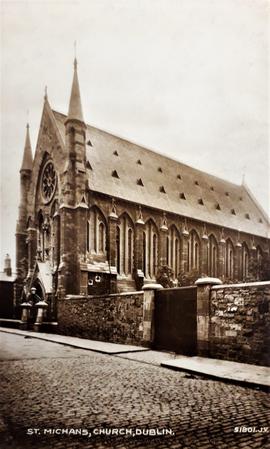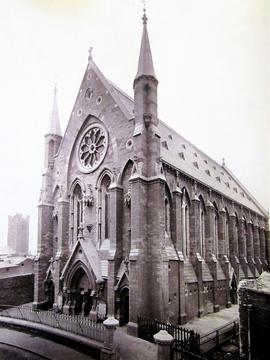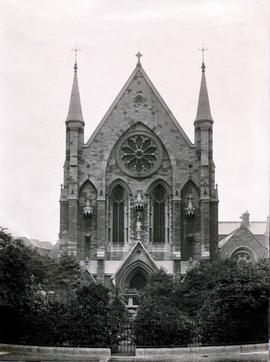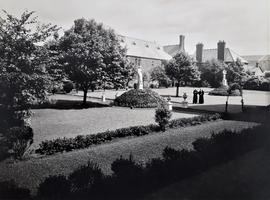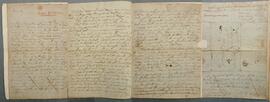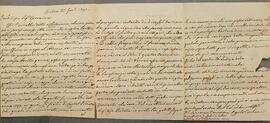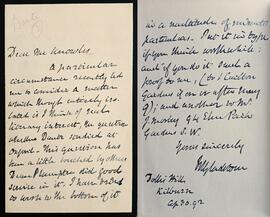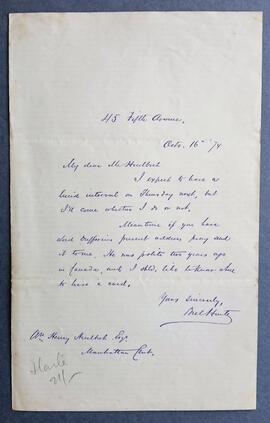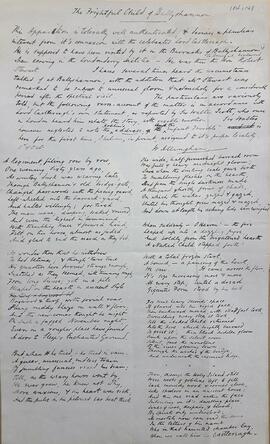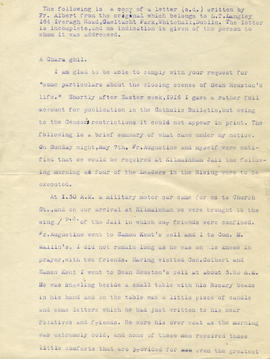Photograph of the exterior of St. Mary of the Angels taken from street level and to the right on Church Street. The photograph shows the church before the addition of the Sacred Heart Chapel, built as an aisle church in 1908.
Photographer / Studio: Valentine’s Post card company
Annotation: The printed title incorrectly identifies the Church as ‘St. Michan’s Church, Dublin’.
Photographic print of the exterior of St. Mary of the Angels taken from a slightly elevated position and to the right on Church Street. The photograph shows the church before the addition of the Sacred Heart Chapel, built as an aisle church in 1908.
Photographic print of the exterior of St. Mary of the Angels, taken from across Church Street showing the gated Father Mathew Park in the foreground.
A photographic print of the garden of the Capuchin Friary on Church Street. Two friars, Fr. Angelus Healy OFM Cap. and possibly Fr. Edward Walsh OFM Cap., are shown in the image. The print shows nearly the full extent of the old friary garden, with the rear of Father Mathew Hall fronting onto Church Street beyond. The photographic studio is credited to C. and L. Walsh, 55 Lower Mount Street, Dublin.
A letter from Rev. Martin Sherlock to J[ohn] Nichols, printer, Red Lion Court, Fleet Street, London. The letter mentions money issues and references his literary talents. Sherlock writes ‘I could write very successful books; and what very few men can do (what no man ever has done, except myself), I could write books in French that would succeed in France; and books in English that would succeed in England’. He also affirms that he has ‘the greatest wish and desire to write, but my fortune will not let me’. A faded pencil annotation on the first page reads ‘Martin Sherlock … author of the ‘Letters of an English Traveller’ (‘Lettres d’un Voyageur Anglois’, published in 1779).
A letter from Cardinal Charles Erskine to Ms Pergoli. The item has a printed extract from an auction catalogue describing the content of the letter. The letter is dated 23 January 1795 at London. Erskine states that when he entertained his correspondent at Chigiano, they never thought that one day 2,000 miles would separate them. The winter in London is very severe, but that of 1740, which doubtless his correspondent remembers, is nothing in comparison. The fog and the smoke prevents him from seeing the sun. He also affirms that he has taken care of the interests of the Holy Father.
A letter from William Gladstone to James Thomas Knowles. The letter refers to the question of whether the medieval philosopher and writer Dante Alighieri studied at Oxford.
A letter from Bret Harte, 45 Fifth Avenue, New York, to Henry Hubert, seeking Lord Dufferin’s address in Canada.
A poem by William Allingham titled ‘The Frightful Child of Ballyshannon’ and dated 1 October 1849. As noted in Allingham’s introduction, the poem refers to a story that a ghostly apparition (taking the form of a child) haunted Robert Stewart, better known as Lord Castlereagh (1769-1822), a leading Anglo-Irish statesman and politician, probably best remembered for his role in suppressing the 1798 Rebellion and in securing the passage of the Act of Union in 1800.
The verse recounts a local tradition that Stewart was visited by the spectre while inspecting a military barracks in Ballyshannon in County Donegal. Allingham suggests that Stewart was subject to an ‘unusual gloom and melancholy for a period after the spectral visit’. Stewart was known to be susceptible to paranoia and later severe mental health problems. It is likely that Allingham’s poem was also influenced by the fact that Stewart was a widely reviled figure in Ireland.
The last stanza of Allingham’s poem reads:
Then, through the Holy Island still
Were nests of goblins left, to fill
Each mouldy nook & corner close,
Like spiders in an ancient house:
And this one read within the face
Intruding on it’s dwelling-place,
Lines of woe, despair, & blood;
By Spirits only understood;
As mortals now can read the same
In the letters of his name
Who in that haunted chamber lay,
When we call him — Castlereagh.
Copy letter from Fr. Albert Bibby OFM Cap. The typescript copy notes that the original ‘belongs to L.T. Langley, 164 Iveragh Road, Gaeltacht Park, Whitehall, Dublin. The letter is incomplete, and no indication is given of the person to whom it is addressed’. The letter provides an account of the ‘closing scenes of Sean Heuston’s life’. Fr. Albert contends that ‘shortly after Easter Week, 1916, I gave a rather full account for publication in the Catholic Bulletin, but owing to the Censor’s restrictions it could not appear in print’. The letter reads: ‘At about 3.45 A.M. a British soldier knocked at the door of the cell and told us time was up. We both walked out together down to the end of the Jail yard; here his hands were tied behind his back, a cloth tied over his eyes and a small piece of white paper, about 4 or 5 inches square, pinned to his coat over his heart’. Reference is also made to Fr. Augustine’s Hayden’s ministry to Ėamonn Ceannt and Michael Mallin.
